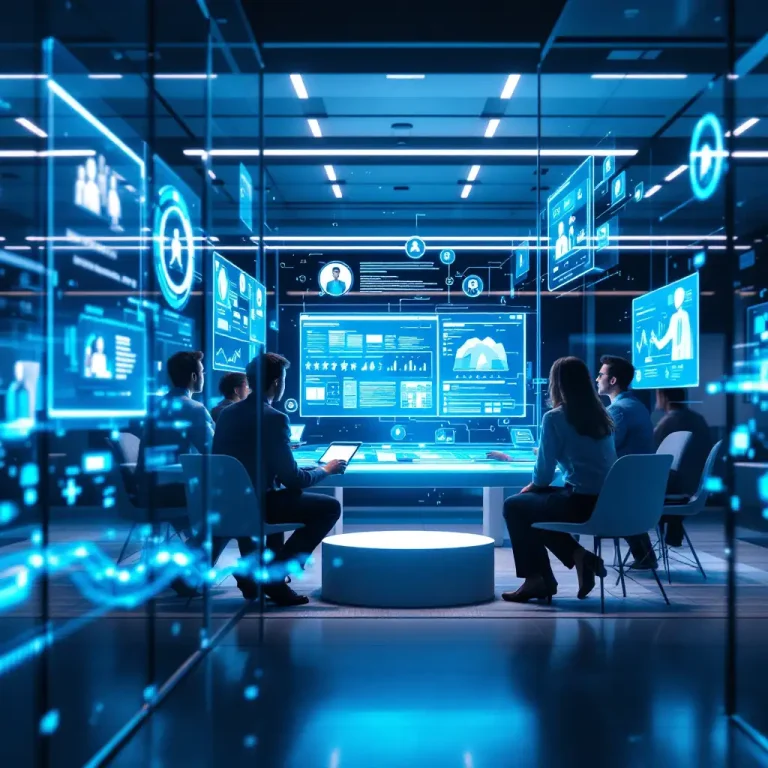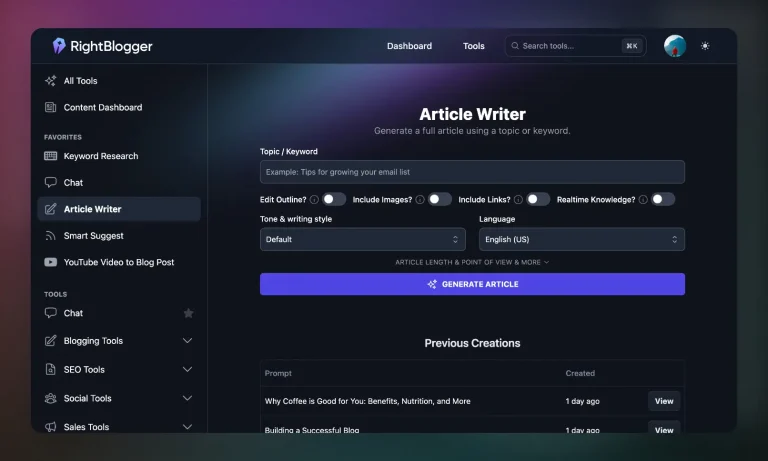In the rapidly evolving digital landscape, generative AI has emerged as a transformative force in content creation. By 2025, an estimated 90% of online content will be produced with AI assistance, fundamentally changing how businesses approach content development. This comprehensive guide explores how AI-powered content tools are reshaping creative workflows, enhancing productivity, and opening new possibilities for creators across industries.

Understanding the Generative AI Revolution in Content Creation
Generative artificial intelligence represents a paradigm shift in how we produce, refine, and distribute content. Unlike traditional AI systems that merely analyze existing information, generative AI models create original content by learning patterns from vast datasets and producing novel outputs that mimic human-created work.
“Generative AI is no longer just a technological novelty—it’s becoming an essential component of competitive content strategies across industries.” — AI Industry Report 2025
The core technology behind this revolution is built upon sophisticated neural networks, particularly Large Language Models (LLMs) like GPT-4 and Claude, which can understand context, maintain consistency, and generate human-like text. Alongside these, diffusion models power image generation tools such as DALL-E and Midjourney, while multimodal systems integrate text, image, and video capabilities.
How Generative AI Differs from Traditional Content Creation
Traditional content creation follows a linear, labor-intensive process:
- Research and planning
- Content drafting
- Revisions and editing
- Finalization and publishing
Generative AI content workflows introduce a collaborative human-AI approach:
- Prompt engineering and goal setting
- AI-assisted content generation
- Human refinement and direction
- Iteration with AI assistance
- Human review and publishing
This partnership between human creativity and machine efficiency has led to unprecedented productivity gains while maintaining (and often enhancing) quality standards.
Applications Transforming Creative Industries
Text Generation: Beyond Basic Copy
Modern AI writing assistants have evolved far beyond simple text completion. Today’s solutions can:
- Generate long-form articles with coherent structure
- Create SEO-optimized content that ranks effectively
- Adapt tone and style to match brand guidelines
- Produce content in multiple languages with cultural nuance
- Draft specialized content like technical documentation
For content marketers, this means the ability to scale production without sacrificing quality. A single creator can now manage content operations that previously required entire teams.
Visual Content Revolution
The visual content landscape has been dramatically transformed by AI image generators and design tools. Brands can now:
- Create custom illustrations without graphic design expertise
- Generate product photography variations efficiently
- Design marketing materials with consistent brand aesthetics
- Produce visual content at scale for multiple channels
- Experiment with visual concepts before committing resources
This democratization of visual creation has leveled the playing field, allowing smaller businesses to produce professional-quality visual assets previously available only to larger competitors with substantial design budgets.
Video and Animation: The Next Frontier
AI video generation represents perhaps the most significant breakthrough in content creation technology. Video, traditionally the most resource-intensive content format, can now be approached with remarkable efficiency:
- Create product demonstrations without filming
- Generate animated explainer videos from text scripts
- Produce personalized video content at scale
- Edit and enhance existing footage automatically
- Convert blog posts and articles into video format
As these technologies mature, we’re witnessing dramatic reductions in video production costs while simultaneously expanding creative possibilities.
Strategic Benefits for Content Teams
Productivity Enhancement
The most immediate impact of content automation comes through significantly improved productivity:
- Content volume: Production capacity increases of 300-500% are commonly reported
- Turnaround time: Projects that once took weeks can be completed in days
- Resource allocation: Creative professionals can focus on strategy rather than execution
- Content diversity: Teams can maintain presence across more platforms and formats
For content marketing teams facing ever-increasing demands, these efficiency gains provide breathing room to focus on strategic initiatives rather than content production treadmills.
Quality Improvements
Contrary to early concerns, AI assistance has generally led to quality improvements:
- Consistency: Elimination of quality variations between content pieces
- Accuracy: Reduced factual and grammatical errors
- Optimization: Better alignment with SEO and conversion requirements
- Personalization: Ability to tailor content to specific audience segments
Organizations leveraging generative AI effectively have discovered that technology enhances rather than diminishes their unique brand voice when properly implemented.
Leading Generative AI Content Creation Tools in 2025
Text Generation Platforms
Several platforms have emerged as leaders in AI-assisted writing:
ToolSpecializationBest ForJasperMarketing copyConversion-focused contentCopy.aiVersatile writingSmall business content needsWritesonicSEO contentTraffic-focused strategiesAnthropic ClaudeNuanced writingComplex, detailed content
The key differentiator among text tools increasingly lies in their specialization and integration capabilities rather than basic writing quality.
Visual Creation Systems
Image generation has seen remarkable advancement:
- DALL-E 3: Pioneering photorealistic image creation from text
- Midjourney: Artistic renderings with distinctive aesthetic qualities
- Stable Diffusion: Open-source foundation enabling customization
- Canva with Magic Studio: Integration of AI generation into design workflows
These tools have progressed from curiosities to production-ready solutions used by major brands for commercial projects.
Implementation Strategies by Industry
Marketing and Advertising
For marketing teams, generative AI offers particular advantages:
- Campaign scaling: Create variations for different channels and audiences
- Personalization: Tailor messaging to individual customer segments
- Testing efficiency: Generate multiple concepts for A/B testing
- Content refreshing: Update existing assets for current campaigns
Leading brands now use AI to generate initial concepts while human creatives refine and direct these outputs.
E-commerce and Retail
Online retailers face unique content challenges that AI addresses effectively:
- Product descriptions: Generate unique descriptions at scale
- Visual merchandising: Create consistent product imagery
- Customer communications: Personalize email and messaging
- Shopping assistants: Power conversational commerce experiences
The ability to maintain fresh, engaging content across thousands of products has proven particularly valuable in competitive retail environments.
Media and Publishing
Traditional publishing operations have found strategic applications:
- Content expansion: Extend coverage into adjacent topics
- Research assistance: Accelerate background research processes
- Format adaptation: Transform content between different mediums
- Personalized experiences: Deliver customized content packages
News organizations initially resistant to AI have increasingly adopted it for specific workflows while maintaining human oversight for critical journalistic functions.
Ethical Considerations and Best Practices
Content Authenticity Challenges
The rise of generative AI has introduced complex questions about content authenticity:
- Disclosure requirements: When and how to disclose AI assistance
- Attribution complexities: Establishing appropriate credit models
- Quality control: Ensuring factual accuracy in AI-generated content
- Originality concerns: Avoiding unintentional duplication
Responsible organizations are adopting transparent policies about AI usage, ensuring consumers understand when technology has contributed to content creation.
Implementing Ethical Guardrails
Leading companies have established frameworks for ethical AI content:
- Human oversight: Maintaining review processes for all AI outputs
- Transparency commitments: Clear disclosure of AI involvement
- Quality standards: Rigorous fact-checking and verification
- Training and education: Ensuring teams understand capabilities and limitations
- Regular auditing: Reviewing AI outputs for bias and quality issues
These practices help organizations balance innovation with responsibility as they integrate generative AI into content workflows.
Future Trends to Watch
The generative AI landscape continues evolving rapidly, with several emerging trends:
AI Reasoning Capabilities
Next-generation models are developing enhanced reasoning abilities, producing content with stronger logical coherence and analytical depth. This advancement will enable AI to assist with more complex content formats requiring nuanced arguments and evidence-based conclusions.
Agentic Systems
Agentic AI represents an evolution where systems can autonomously execute multi-step content tasks with minimal human intervention. These capabilities will enable end-to-end content workflows with human direction primarily at strategic levels.
Multimodal Integration
The boundaries between text, image, audio, and video creation are dissolving as unified systems emerge that can seamlessly work across formats. This integration will enable truly omnichannel content creation from single inputs.
Practical Implementation Guide
Organizations looking to implement generative AI for content creation should follow a structured approach:
- Audit current content processes to identify opportunities for AI enhancement
- Start with pilot projects in low-risk content areas
- Develop clear guidelines for human-AI collaboration
- Invest in prompt engineering skills among content teams
- Establish quality control workflows with appropriate human oversight
- Measure outcomes against established content metrics
- Iterate and expand based on results
This measured approach helps organizations capture value while managing change effectively.
Case Study: Transformation in Action
Regional e-commerce retailer HomeStyle implemented generative AI across their content operations in late 2024, with remarkable results:
- 73% reduction in time-to-publication for new product listings
- 42% improvement in conversion rates through optimized product descriptions
- 68% increase in organic traffic from enhanced SEO content
- $1.2M estimated annual savings in content production costs
By combining AI generation with human strategic direction, HomeStyle maintained brand voice while dramatically scaling content capabilities.
FAQ: Generative AI for Content Creation
Q: Will AI replace human content creators?
A: No—AI is transforming the role of creators rather than eliminating it. Human expertise remains essential for strategy, emotional intelligence, and creative direction. The most effective approaches combine AI efficiency with human creativity.
Q: How can we maintain brand voice with AI assistance?
A: Modern AI tools can be effectively “trained” on your brand guidelines and existing content. Combining this with human review ensures consistency with established brand voice while benefiting from AI productivity.
Q: What skills should content teams develop to work effectively with AI?
A: Prompt engineering, strategic thinking, editing/refinement, and quality control have become increasingly valuable. Technical understanding of AI capabilities and limitations also helps teams leverage these tools effectively.
Q: How should we disclose AI involvement in content creation?
A: Transparency builds trust. Consider a clear policy stating when and how AI is used in your content processes, either through direct disclosure on content pieces or through a general policy statement accessible to audiences.
Q: How can we measure ROI from generative AI implementation?
A: Track metrics including content production volume, time-to-publication, engagement metrics, conversion rates, and team efficiency. Compare these against pre-implementation benchmarks to quantify benefits.
Conclusion: The New Content Creation Paradigm
Generative AI has permanently altered the content creation landscape. Organizations that strategically embrace these technologies while maintaining human creative direction will enjoy significant competitive advantages in efficiency, quality, and scalability.
The most successful implementations recognize that AI serves as a powerful tool augmenting human creativity—not replacing it. By establishing thoughtful processes combining technological capabilities with human insight, forward-thinking organizations are redefining what’s possible in content creation.
As we move through 2025, the question is no longer whether to adopt generative AI for content creation, but how to implement it most effectively to achieve strategic objectives while maintaining authentic connections with audiences.



